Career Fire Captain Dies When Struck by a Pickup Truck While Working at the Scene of Two Traffic Incidents - California
 Death in the Line of Duty...A summary of a NIOSH fire fighter fatality investigation
Death in the Line of Duty...A summary of a NIOSH fire fighter fatality investigation
F2012-07 Date Released: June 28, 2013

Photo of the incident scene.
(Photo courtesy of Redding Record Searchlight.
Photo by Andreas Fuhrmann)
Executive Summary
On February 29, 2012, a 35-year-old male career Captain (the Victim) was struck and killed by a pickup truck as it slid off of an interstate highway following a hail storm that had caused numerous motor vehicle crashes. The Victim and a fire fighter were dispatched to an area of the highway where two vehicles had slid off of the roadway in the same location but in two separate incidents.
The driver of one of the vehicles, a highway patrol officer, the fire fighter, and the Victim were standing near the roadway to the rear of the parked fire department patrol vehicle when an out-of-control pickup truck slid toward them. The fire fighter ran to the front of the fire patrol vehicle and was not injured. The highway patrol officer suffered injuries from diving to the ground and falling. The Victim and the civilian driver were unable to get out of the truck's path and were struck as the truck rolled down the embankment. The highway patrol officer and the civilian driver were injured and transported to a local medical center. The Victim was transported by ambulance to the local medical center where he was pronounced dead from multiple blunt force trauma
Contributing Factors
- Motorist traveling at an excessive speed for the road conditions
- Motorist lost control of vehicle while passing a highway emergency scene
- Weather / hail storm resulted in a slippery road surface
- Victim’s location with respect to out-of-control vehicle.
Key Recommendations
- Develop, train on, and enforce standard operating procedures (SOPs) for roadway incidents that include response protocols for all possible types, locations, and durations of emergency roadway incidents that may occur within the department's jurisdiction
- Develop pre-incident plans regarding response protocols, scene safety, and traffic control for roadway emergency work zones in conjunction with public safety agencies, traffic management organizations and private sector responders
- Ensure that all members receive guidance and training for responding to roadway incidents, with specific instruction on positioning apparatus and personnel to protect emergency workers from oncoming traffic
- Develop and train members on a situational awareness program that addresses hazards specific to working at a roadway emergency work zone
- Ensure that a thorough scene size-up is conducted, incident command is established, and risks are assessed and managed throughout a roadway incident
- Ensure that SOPs include guidance on how to properly establish advance warning and transition areas for highway emergency incidents
- Ensure that fire fighters wear suitable high-visibility retro-reflective apparel while working non-fire emergency scenes near moving traffic
- Ensure that high visibility chevrons and reflective markings are applied to all apparatus to enhance conspicuity while parked at emergency scenes and during emergency response
- Ensure that all persons involved in training and operations of emergency response meet applicable requisite knowledge and skills.
Introduction
On February 29, 2012, a 35-year-old male career Captain (the Victim) was struck and killed by a pickup truck that slid off of an interstate highway following a hail storm. On March 1, 2012, the U.S. Fire Administration (USFA) notified the National Institute for Occupational Safety and Health (NIOSH) of this fatality. At the department's request, the investigation was delayed until March 29, 2012, when an Occupational Safety and Health Specialist from the NIOSH Fire Fighter Fatality Investigation and Prevention Program traveled to California to investigate the incident.
The NIOSH investigator met with and interviewed persons from the fire department who were on the scene when, and shortly after, the incident occurred. Fire department representatives accompanied the NIOSH investigator to view and photograph the fatality scene. The NIOSH investigator reviewed the department's SOPs, witness statements, the victim's training records, and the police report.
Fire Department
The combination department involved in this incident has one fire station serving a rural response area of 36 square miles. A total of 23 members, four full-time paid, three part-time paid and 16 volunteers serve about 5,000 residents and respond to approximately 800 emergency calls per year.
The department has four engines, one water tender, one patrol vehicle and two command vehicles. At the time of the investigation, the department did not have a written SOP on emergency roadway operations.
Work schedules follow what the department referred to as a "modified Kelly shift," which calls for the employees to work 24 hours, off 24 hours, work 24 hours, off 24 hours, work 24 hours and then have the next four consecutive days off. Shifts were from 0700 hours to 0700 hours the following day. The Victim was working his last shift of the schedule and was to begin four days off at the end of the shift.
Training and Experience
The Victim had been a fire fighter for more than nine years and had been a career Captain with the current department for over six years. He had successfully completed training in many courses including Fire Fighter I and II, apparatus/engine operations, self-contained breathing apparatus, Hazmat, live fire training, Wildland Fire Fighter I-IV and was an Emergency Medical Technician.
Vehicles, Equipment and Personnel
The following vehicles and apparatus were on the scene or involved in the incident in some way:
- Car #1 – A 1997 sedan travelling south on the interstate highway at an estimated speed of 60 MPH when it left the road to the right and slid down an embankment. It sustained contact damage in numerous locations from overturning and major damage to its hood from the collision with Car #2. The driver was wearing a seat belt and was uninjured. He was taken from the scene by a family member.
- Car #2 – A 2006 sedan that was travelling south on the same highway as Car #1, at an estimated speed of 55 to 60 MPH when it slid off of the road and traveled down the embankment. It overturned and came to rest on its wheels with the right rear tire resting on the hood of Car #1. It sustained contact damage in numerous locations from overturning and rear to front damage caused by the collision with the pickup truck. The driver was wearing a seat belt and was not injured in the initial incident but was injured when struck by the truck.
- Pickup Truck – A 2003 extended cab pickup truck that was travelling south on the same interstate highway as Car #1 and Car #2, at an estimated speed of 65 to 70 MPH. Contact damage to the truck was extensive from overturning and colliding with both Car #1 and Car #2. The driver who was wearing a seat belt, suffered minor injuries and did not require medical treatment at the time.
- Highway Patrol Car –A marked black and white police interceptor sedan equipped with overhead emergency lights and directional arrow bar was driven to the incident scene by a Highway Patrol Officer. It was parked on the southbound right shoulder with the roof-mounted, rear-facing emergency lights activated and the amber directional lights illuminated to direct traffic to the left. The Highway Patrol Officer was injured when he dove to the ground and fell while running to get out of the path of the pickup truck.
- Fire Department Patrol Vehicle – The truck was driven to the scene by the Victim and was parked on the southbound right shoulder 54 feet to the south of the highway police car. The red rear-facing emergency lights were activated. The Victim and another fire fighter arrived in this truck.
Timeline
The timeline for this incident details all activities pertaining to the vehicle crash.
| Incident Timeline |
Time
|
Pertinent Incident Activity
|
|---|---|---|
| A hail storm passed through the crash area. |
0450
|
The first vehicle, Car #1 slid off the highway and down an embankment. |
| A Highway Patrol Officer arrived on the scene. |
0455
|
After assuring the driver was not injured, the Officer called for a tow truck and left the scene to respond to another reported motor vehicle crash. |
| The Highway Patrol Officer returned to the scene. |
0545
|
The Highway Patrol Officer returned to the scene. |
| A second vehicle lost control while passing the incident scene. |
0549
|
The second vehicle, Car #2, slid off the highway in the same location as Car #1, nearly striking the patrol car. It overturned while sliding down the embankment and came to rest partially on top of Car #1. |
The Victim and fire fighter arrived on the incident scene. |
0600
|
They proceeded to check the persons involved for injuries. |
| A third vehicle, pickup truck, lost control while passing the incident scene. |
0614
|
The pickup truck slid off the highway in the same location as Cars #1 and #2. It struck the Victim and driver of Car #2 as it overturned while sliding down the embankment. |
| The Victim was transported to a local medical center. |
0717
|
He was pronounced dead upon arrival. |
Road and Weather Conditions
The incident involved a major north-south interstate highway that had six travel lanes, three northbound and three southbound. In the area of the incident, the southbound lanes passed over a local roadway (see Photo 1). The original overpass was constructed in 1964 and the deck was covered with a polyester concrete overlaya in 2008. The overlay was tinedb, which removed the smooth polyester surface and provided a granular wear surface.
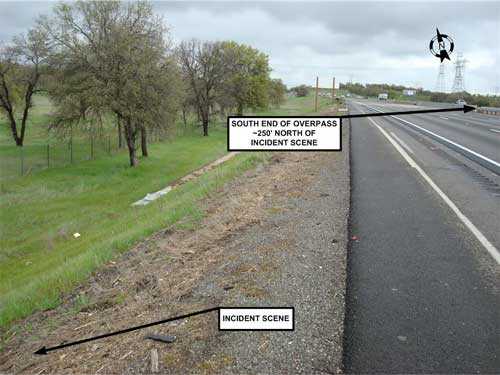
Photo 1. Photo of the highway near the incident scene facing north.
(NIOSH Photo)
In 2011 the overpass deck was widened on the median side to accommodate a third lane, which is commonly known as the passing lane and is referred to throughout the report as Lane #1. Lane #2 is the middle lane and Lane #3 is adjacent to the outside shoulder and is commonly called the slow lane. The newly installed third lane was also covered with a polyester concrete overlay, which was tined, to match the original surface. However, the tining on southbound Lane #1 was more severe than Lanes #2 and #3. To the south of the overpass, and closer to the incident area, the roadway pavement was composed of asphalt concrete. The road shoulders in the area of the incident measured between 9 and 10 feet in width. The road had a gradual right curve and a slight downgrade. The speed limit in the area was 70 miles-per-hour (MPH) for passenger vehicles.
The temperature at the time of the incident was approximately 36°F with calm winds around 2 MPH. Area weather station records show that hail had fallen one hour and twenty-four minutes prior to the fatal incident, which would have been around the time the first crash occurred.1 There was approximately one fourth to one inch of hail that had accumulated on Lane #1, left shoulder, and right shoulder of the southbound lanes according to witnesses who traveled through the collision scene at varying times (see Photo 2).
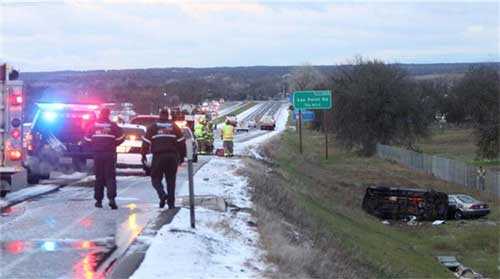
Photo 2. Photo shows the incident scene facing south and hail accumulation on road shoulder.
(Photo courtesy of Redding Record Searchlight.
Photo by Andreas Fuhrmann)
Prior to the fatal incident, the State Highway Patrol had requested dispatch to program a changeable message sign in the area to warn of the weather conditions ahead. Approximately one half to three fourths of a mile to the north of the incident area, a Patrol Officer had placed two flares in the median and two flares on the west shoulder of southbound lanes about 100 feet apart. He chainedc the flares together with three additional flares. Patrol Officers also requested the communication center notify the news media of the conditions and to have the highway department dispatch trucks to plow the roadway. The #2 and #3 lanes had been cleared of hail by the state highway department prior to the incident. A review of video footage captured on the Highway Patrol Mobile Video/Audio Recording System (MVARS) showed that the boundary where the hail began was to the north of the roadway overpass which was just north of the incident scene (see Diagram 1). The video also showed that during the 12 minutes prior to the fatal incident, 78 southbound vehicles, six travelling in lane #1, passed safely by the patrol car while it was parked along the shoulder. There is no evidence that the road composition or design was a contributory factor in this incident. Official sunrise on February 29, 2012 was at 0643 hours. There was no artificial lighting in the area where the incident occurred.
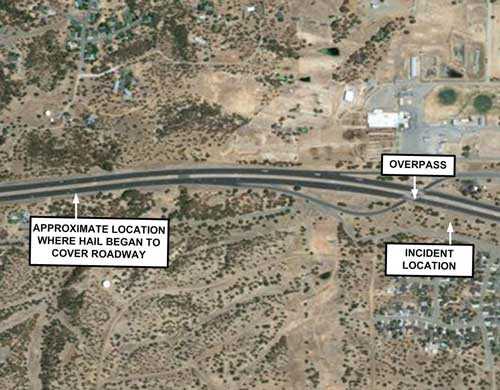
Diagram 1. Showing aerial view of incident scene and location where hail began to cover the highway.
(Depiction taken from Google Maps)
aPolyester concrete is composed using as polyester resin binder which differs from traditional asphalt concrete where the binder is cement.
bTining creates a grooved or roughened road surface texture by dragging various materials or tools across freshly poured concrete. The purpose is to reduce vehicle skidding and hydroplaning.
cChaining flares together is done so that all flares ignite sequentially and do not have to be lit individually. This is achieved by removing the ignition cap from the flare which is then set down toward the end of the preceding flare.
Investigation
On February 29, 2012 at approximately 0450 hours, a hail storm, which was an uncommon occurrence in the area, passed over a section of interstate highway (see Diagram 1). It was reported by drivers who were traveling through the area that there was not a gradual entry into the hail. They stated that the road was clear and then all of a sudden it was covered with hail. Police reported that immediately following the storm, numerous traffic incidents occurred in the area. The state highway department was dispatched to plow the hail and clear the road. A highway truck had passed through the area prior to the incident, plowing lanes #2 and #3 leaving lane #1 mostly hail covered.
After the hail storm had passed, the Victim (35 year-old male career Captain), who was approximately an hour away from the end of this shift, was dispatched to a report of a multiple vehicle incident along the interstate highway where the hail storm had occurred. Information provided was that two vehicles, at two separate times, had skidded off of a hail covered interstate highway. Both vehicles came to rest at the foot of a westward sloping approximate 40 foot embankment with the second vehicle coming to rest on top of the first (see Diagram 2 and Diagram 3). It was reported that there were no injuries and that a highway patrol officer was on the scene.
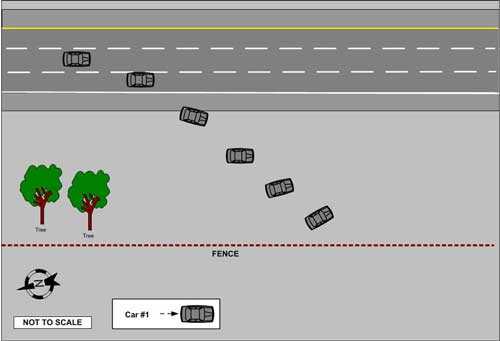
Diagram 2. Diagram depicts Car #1 sliding off the highway at 0450 Hours.
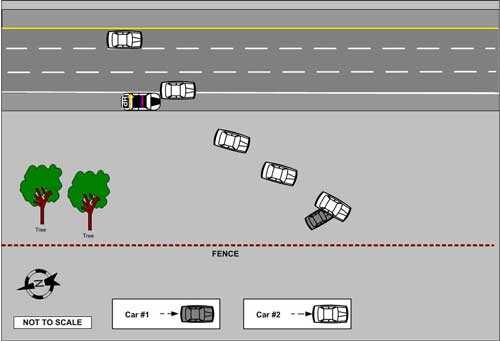
Diagram 3. Diagram depicts the arrival of the Highway Patrol Officer at 0545 Hours, and the path of travel of Car #2 as it slid off of the highway at 0549 Hours.
The Victim responded to the scene in a department utility truck with one additional fire fighter (FF) on board who was sitting in the front passenger seat. Upon arriving at the scene, he parked approximately 54 feet to the south of the highway patrol car (see Diagram 4).
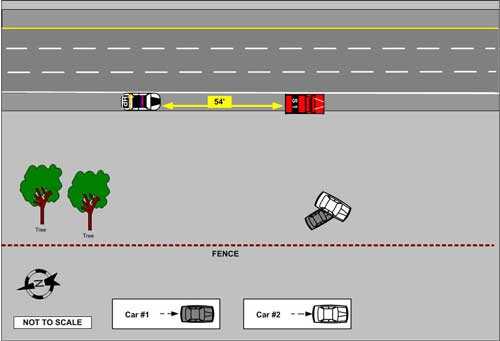
Diagram 4. Diagram depicts the arrival of the victim to the incident scene at 0600 Hours.
The Victim had activated the fire department patrol vehicle's emergency lights during the response to the scene and left them on when he exited the vehicle and proceeded down the embankment to meet with the Highway Patrol Officer and check on the occupants of the crashed vehicles. After determining there were no injuries, the Victim, Fire Fighter, Highway Patrol Officer, and the driver of Car #2 walked up the embankment to exchange information. All four were standing on, and/or near, the road shoulder and to the north of the fire patrol vehicle when they saw a southbound black pickup truck careening out of control in a sideways skid toward them (see Diagram 5).
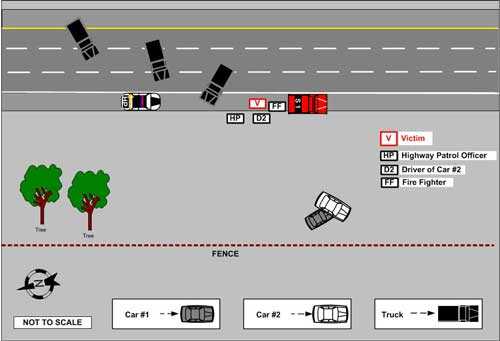
Diagram 5. Diagram depicts the location of the Victim, Fire Fighter, Highway Patrol Officer, and Driver of Car #1 as the pickup truck began to slide off of the highway.
The driver of the pickup truck reported to police that he had been travelling south on the interstate highway in the #2 lane at approximately 65 to 70 MPH. The roads were clear and traffic was moving at the speed limit when suddenly he came upon hail covering the roadway. As he came to the crest of a grade he noticed flashing lights on the right road shoulder approximately one half mile to the south. As he drove closer to the emergency scene, traffic began to slow and he reduced his speed to between 50 and 60 MPH. However, to avoid a collision with the slowing vehicles in front of him, he swerved toward the left into Lane #1 and lost traction because of the hail that was still covering that portion of the highway. Upon swerving into Lane #1, the left rear of the truck collided with the east concrete bridge rail, and then rotated in a clockwise direction sliding in a southwesterly direction across the southbound lanes before traveling off the roadway. The truck rolled down the embankment onto the driver side, and then began to roll onto its roof, rotating 180° before coming to rest on the driver's side at the foot of the embankment and up against the other two wrecked vehicles (see Diagram 6).
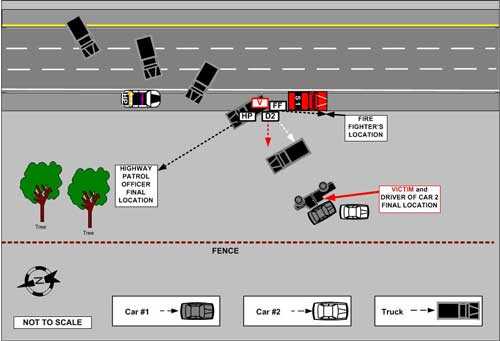
Diagram 6. Diagram depicts the final incident progression and location of all vehicles and persons involved in the incident.
In an attempt to escape the out-of-control truck, FF1 ran to the front passenger side of the fire department utility truck and the highway patrol officer headed down the embankment in a northwesterly direction. The Victim initially side-stepped in a westerly direction and then ran in a northwesterly direction. The driver of Car #2 ran in a westerly direction. The Highway Patrol Officer dove to the ground to avoid being struck by the pickup truck. The driver of Car #2 fell to the ground in a deliberate attempt to avoid being struck, but as the truck overturned, it hit his right side as he lay on the ground.
The Victim continued to run in a northwesterly direction and was struck by the left side of the pickup truck which propelled him into the air and again into the truck's path. The truck continued to overturn in a southwesterly direction until coming to rest when it crashed into Car #1 and Car #2 (see Photo 3). The Victim and the driver of Car #2 were both found near the cab area of the pickup truck.
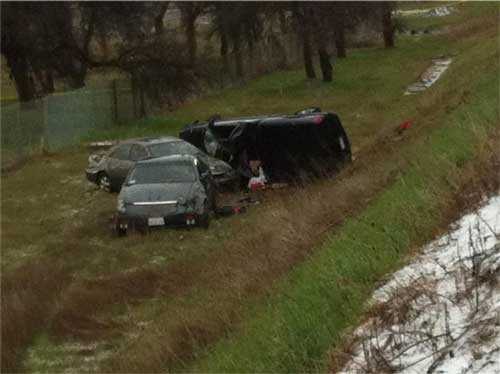
Photo 3. Photo shows final location of all vehicles involved in the incident.
(Photo courtesy of Redding Record Searchlight.
Photo by Andreas Fuhrmann)
The Highway Patrol Officer was transported by helicopter and the driver of car #2 was transported by medical ground ambulance. Both were taken to a local medical center, where they were admitted and treated for serious but non-life threatening injuries. The Victim was transported by ambulance to the local medical center where he was pronounced dead at 0717 hours by the attending physician.
The police report identified the main cause of the incident to be unsafe turning movement and excessive speed for the conditions by the driver of the pickup truck.
Contributing Factors
Occupational injuries and fatalities are often the result of one or more contributing factors or key events in a larger sequence of events that result in the injury or fatality. NIOSH investigators identified the following items as key contributing factors in this incident:
- Motorist traveling at an excessive speed for the road conditions
- Motorist lost control of vehicle while passing a highway emergency scene
- Weather / hail storm resulted in a slippery road surface
- Victim's location with respect to out-of-control vehicle.
Cause of Death
According to the death certificate, the Victim died from multiple blunt force trauma.
Recommendations
Recommendation #1: Develop, train on, and enforce standard operating procedures (SOPs) for roadway incidents that include response protocols for all possible types, locations, and durations of emergency roadway incidents that may occur within the department's jurisdiction.
Discussion: One of the primary means by which departments establish consistent operations and manage risk is through the adoption and enforcement of SOPs. The development and enforcement of SOPs related to emergency vehicle response procedures and roadway incident scene operations are particularly important due to the level of hazard these operations pose for responders. SOPs should include guidance on methods to protect all emergency responders on the scene and maintain a safe flow of traffic past, or around, the emergency work zone. Roadside emergency work zone SOPs should include specific direction on:
- safe travel response protocols, apparatus placement at the scene, and markings
to increase visibility - establishing incident command
- performing initial scene size-up and continual assessment of risks,
- training on the need and process for maintaining on-scene situational awareness
- requirements for the use of personal protective equipment (PPE)
- safe placement of advance warning signs and transition areas.2
NFPA 1500, Standard on Fire Department Occupational Safety and Health Program states that, "The fire department shall provide training, education, and professional development for all department members commensurate with the duties and functions that they are expected to perform."3 All training should be in compliance with NFPA 1451, Standard for a Fire and Emergency Services Vehicle Operations Training Program.4
The department involved in this incident did not have a SOP on roadway operations to provide definitive guidance on methods to protect emergency responders who are attending to highway incidents. It was accepted practice to respond to highway incidents with the fire patrol vehicle being first out. A SOP should be developed that outlines how properly positioned fire apparatus would provide a larger and more substantial area of protection from out-of-control vehicles, especially along fast moving, limited-access, multiple-lane highways.
Recommendation #2: Fire departments should develop pre-incident plans regarding response protocols, scene safety, and traffic control for roadway emergency work zones in conjunction with public safety agencies, traffic management organizations and private sector responders.
Discussion: Pre-incident planning is fundamental to effective traffic control and management.3 According to the Emergency Responder Safety Institute, a preplan should: (1) account for possible use of detours; (2) anticipate the likelihood of vehicles transporting hazardous materials or of extraordinary weight or size; (3) accommodate the need to keep commerce flowing; (4) minimize the possibility of secondary incidents; and (5) account for possible impact on neighboring jurisdictions.5 According to the US Fire Administration document, Traffic Incident Management Systems,6 specific concepts that should be addressed in pre-incident planning for roadway incident operations include the following:
- All agencies that may respond to roadway incidents should be fully involved in the process, formatting and developing the plan, and ensure that the final plan is easily understood and implemented within their agency. (As noted in NFPA 1620 Section 4.1.9)7
- Each agency involved must provide initial and refresher training, and ensure that individual and organizational roles are understood. (As noted in NFPA 1620 Section 4.8)7
- Each agency should make sure that personnel are at least minimally briefed on the roles and procedures of other plan participants to avoid on-scene confusion and conflict. (As noted in NFPA 1620 Section 4.9)7
NFPA 1620 provides guidance to assist fire departments in establishing pre-incident plans that include agreements formed by a coalition of all involved parties.7 Governing entities, including departments of transportation, in conjunction with fire departments, emergency medical responders, law enforcement, and private sector responders (i.e. tow truck operators), should develop pre-incident plans that include automatic response protocols for highway emergency scenes. States and municipalities should ensure that adequate funding is available to staff and equip emergency response protocols once jointly established and agreed upon by all parties involved.
At the time of this incident, the adverse weather conditions had created a chaotic atmosphere on the roadways due to numerous traffic crashes. Local emergency responders, including police, ambulance, tow operators and the fire department were receiving requests to respond to an unusually high number of traffic incidents due to deteriorating road conditions caused by the hail. Even though recreating this scenario for pre-incident planning purposes may be difficult, the fact that it did occur should be incorporated in the discussion for future planning and training.
Recommendation #3: Fire departments should ensure that all members receive guidance and training for responding to roadway incidents, with specific instruction on positioning apparatus and personnel to protect emergency workers from oncoming traffic.
Discussion: Although it may be difficult to ensure emergency workers are protected from every danger that is presented by traffic moving past an emergency work zone, there are actions that can be taken to mitigate hazards. Department SOPs should outline methods to be followed based on pre-incident planning for responding to specific incidents. Pre-incident planning is crucial in determining response strategies that provide optimum protection for on-scene emergency responders.
This incident reinforces the need for fire departments to improve training for firefighters on important factors to consider when positioning apparatus at incident scenes. Training should include applicable provisions of NFPA 1500 Standard on Fire Department Occupational Safety and Health Program3 and NFPA 1451 Standard for a Fire and Emergency Services Vehicle Operations Training Program.4 Fire department personnel should be trained on and consider the following points when arriving at an incident before positioning the truck:
- Blocking vehicles should be positioned at an angle (30 – 45 degrees) in any lane and/or shoulder area where there will be personnel working.
- Blocking apparatus can be positioned angled to the right or left depending on several factors:
- Use the angle of the truck to sufficiently cover the work zone and do not leave any openings large enough for a vehicle to pass through.
- Use the angle of the truck to guide traffic in the direction you want them to travel (angled to the right will help shift traffic into the right lanes while trucks angled to the left will help to shift traffic to the left).
- Consider the task at hand and where fire fighters will be working. If pulling hose lines and using a pump operator, consider angling the truck to protect the pump operator. Put the pump panel on the downstream side of the traffic flow.
- If the first in unit will be angled to protect the pump operator and the truck will not be positioned in the best way to direct traffic around the incident, a second unit should be positioned upstream of the first in unit angled in the direction you want traffic to flow. When the incident is of sufficient duration and it can be safely accomplished, supplement the blocking vehicle with the liberal use of cones, flares and warning signs.
- Remember that the angle of the truck helps approaching motorists to understand that the unit is stopped, parked and not moving.8
Remember to turn the steering wheel away from the incident work zone, set the brakes and deploy chock blocks.9 The Manual on Uniform Traffic Control Devices (MUTCD) guidelines can be utilized to establish emergency work zones and provide guidance to ensure that all tasks responders are required to perform can be done within an area that is protected from moving traffic.10 Departments should make every effort to utilize available on-scene physical barriers such as guardrails, and area topography when possible, to create a protected work area that passing traffic cannot breach.
The actual location where emergency responders were working at this incident scene was approximately 50 feet off of the roadway and was a large area. There was no way to predict the exact path of travel of an out-of-control vehicle, however the fact that two vehicles had previously lost control in the same place should indicate the need to be extremely vigilant as to the possibility of another incident occurring in the same way and in the same area. Because of the location and area involved, there is no guarantee that if the police cruiser and the fire department vehicle had been placed differently a tragedy would have been avoided. Due to the high number of traffic incidents that morning because of the hail storm, there were not enough emergency vehicles at the scene of this incident to totally protect the emergency work zone. The fact that this fatality occurred the way that it did emphasizes the need to always prepare for the worst case scenario when working near moving traffic.
Recommendation #4: Fire departments should develop and train members on a situational awareness program that addresses hazards specific to working at a roadway emergency work zone.
Discussion: Situational awareness can be described as a genuinely heightened consciousness or cognizance of what is currently developing or occurring; a three step process where responders (1) capture clues and cues in their operational environment, (2) process the clues and cues into meaning, in the context of space and time, and (3) make predictions about future events with consideration to the first two steps. Being alert to what is occurring at a roadway emergency incident is extremely critical because roadway incidents are always high risk events. Complacency, redundancy, and lack of situational awareness are issues that all responders must avoid. When responding to a roadway emergency incident, fire fighters and other first responders must ensure their personal safety, as well as the individuals they are trying to assist. Emergency personnel need to develop a heightened level of vigilance to detect impending dangerous situations and recognize warning signals such as screeching tires, horns, smoke or dust, and the sound of a crash or impact. Responders need to do a quick survey of the location where they are working and mentally prepare an escape strategy.8
Approaching traffic may be travelling at speeds from a creeping pace to well beyond the posted speed limit. Some of these drivers may be vision impaired, under the influence of alcohol and/or drugs, or have a medical condition that affects their judgment or abilities. Also, motorists may be completely oblivious to your presence due to distractions caused by cell phone or smart phone use, texting, loud music, conversation, inclement weather, and terrain or building obstructions. Approaching motorists will often be looking at the scene and not the roadway in front of them. Nighttime incidents requiring personnel to work in or near moving traffic are particularly hazardous. Visibility is reduced and driver reaction time to hazards in the roadway is slowed.8 Motorists’ attention can be drawn toward the flashing bright lights of emergency vehicles parked along the incident scene or their vision may be impaired by the glare of scene lighting.
To ensure that first responders maintain a heightened level of vigilance, they need to understand the incident action plan which must be communicated by the Incident Commander at the beginning and maintained throughout the duration of the incident. The operations at a highway/roadway incident must be continually reassessed, especially as incident objectives are met, and additional resources arrive, and/or are released from the incident.11 It's important for all emergency responders to remember that things can go very wrong very quickly at roadway emergency incidents. Fire departments need to ensure that multiple prevention strategies are in place and emergency responders must maintain an awareness to what is going on around them at all times. Fire departments should train members on how to identify and pre-plan an escape strategy should they encounter a dangerous situation such as an out-of-control vehicle entering the emergency work zone.
History shows that there is no place at a roadway emergency scene that provides 100% guarantee of safety for persons attending to the incident. Emergency responders have been killed even when remaining inside their vehicle while attending to a highway incident.12 After all prudent steps have been taken to secure the emergency work zone from danger, developing and maintaining a heightened state of situational awareness remains the best personal defense. In this incident, two crashes had already occurred in the same location, which should alert emergency responders to the possibility of another occurrence in the area. A safer approach may have been for all four persons involved in the incident to have secured themselves in the shadow of the fire department fire patrol vehicle using it as a barrier to oncoming traffic, and possibly one of the responders acting as a spotter for oncoming traffic.
Recommendation #5: Fire departments should ensure that a thorough scene size-up is conducted, incident command is established, and risks are assessed and managed throughout a roadway incident.
Discussion: Roadway emergency incidents that occur on or near moving traffic must be effectively and safely managed due to the multitude of risks encountered by fire department and other emergency response personnel. Other first responders can include law enforcement; emergency medical services; State, county, and/or local transportation agencies (e.g. department of transportation); and vehicle recovery agencies. Each agency has a responsibility based upon their designation. For example, law enforcement agencies are often the first to arrive at the incident scene, performing first responder duties, establishing emergency access routes, and controlling the arrival and departure of other responders. Fire and rescue agencies are needed at incidents that involve victim rescue, firefighting operations, or hazardous materials mitigation. They may be supported by emergency medical services (EMS) if the incident involves injuries. Transportation agencies perform a variety of duties related to traffic operations, motorist information, emergency roadwork, and incident clearance, as well as the first responder duties of highway service patrols. Finally, towing and recovery companies recover and remove vehicles and other debris from the scene.11
The management of an incident involving multiple agencies can be difficult. There is always the possibility of disagreement when determining who is in charge of what. The incident commander needs to manage conflicting priorities and coordinate responders who may view their activities as independent of others operating at the scene. Pre-incident planning to identify each responding agency and their particular role and responsibility can avoid disagreements when an incident occurs. Additionally, mutual aid agreements should be established that identify specific responses to deliver appropriate equipment and staffing for the incident. Depending on the size and complexity of the incident, the option of single command or unified command must be considered. Regardless, the Incident Command System (ICS) must be used as this process is a systematic tool for the command, control, and coordination of an emergency response. ICS allows agencies to work together using common terminology and operating procedures for controlling personnel, facilities, equipment, and communications at an incident scene.13
During incident response, the ICS allows the transition to large and/or multiagency operations with only minimal adjustment for the agencies involved. While the ICS structure may be small initially, its flexibility allows the structure to expand and adapt to real-time conditions at the scene. If the incident grows in size and/or complexity, individuals in addition to the Incident Commander may be appointed to oversee their functional units to maintain a reasonable span of control and level of efficiency. It is imperative that "Command" be established by the first arriving unit at all highway incidents. The Incident Commander is the overall safety officer and is responsible to ensure safe working conditions. Depending on the type, duration, and length of an incident, the Incident Commander may appoint an Incident Safety Officer to monitor scene safety.
As in any other operation, accountability of personnel is mandatory. However, in an incident where multi-agencies have personnel and resources at the incident scene, accountability is even more difficult. An accountability group may be established with representatives from multiple agencies assisting in this task. This is another issue for the pre-incident planning process. A personnel accountability system must be used to ensure that all responders are accounted for when on-scene and in the event that an incident occurs which requires the rapid accounting of all personnel on-scene.14
The fact that two vehicles slid off the highway and crashed in the very same location (see Photo 3) should put all persons arriving at the scene on heightened alert to the chance of another similar crash. Incident command should be established and the Incident Commander should put appropriate procedures in place to protect all on-scene emergency responders.
This incident was unique in that an uncommon weather event caused road conditions to deteriorate very quickly. Local emergency responders, including police, ambulance, tow operators and the fire department were receiving requests to respond to an unusually high number of traffic incidents due to deteriorating road conditions caused by the hail. When this type of situation occurs, the possibility of an optimum apparatus response and on-scene placement may be less likely, and an established Incident Command system can continually remind responders to be even more vigilant and remain on a heightened state of awareness as to what is happening around them.
Recommendation #6: Fire departments should ensure that SOPs include guidance on how to properly establish advance warning and transition areas for highway emergency incidents.
Discussion: The Manual on Uniform Traffic Control Devices provides direction for establishing a protected work area for persons working along roadways, including emergency work zone responders. Chapter 6 I provides instruction on the "Control of Traffic Through Traffic Incident Management Areas" which are defined as "an area of a highway where temporary traffic controls are installed, as authorized by a public authority or the official having jurisdiction of the roadway, in response to a road user incident, natural disaster, hazardous material spill, or other unplanned incident." Traffic incidents are divided into three general classes according to the duration; major, intermediate, or minor, with each having unique traffic control characteristics and needs.10
The fire department in this incident was originally responding to a single vehicle crash, but by the time they arrived, another vehicle had crashed in the exact same place. There was not an active incident scene in a roadway travel lane and no responders were working in a travel lane. The main incident area was entirely off of the road. Law enforcement was on the scene, but due to the large number of incidents in the area related to the hail storm, it was unlikely that additional units could have been dispatched to the scene.
Even though the hail storm and resulting slippery road conditions was a major factor in this incident, there are additional procedures that should be considered to further enhance the safety of responders who are working in a roadway emergency work zone. Had there been one available, it is possible that an upstream emergency vehicle could have alerted traffic to reduce speed prior to entering the roadway where the hail covered the road. Also a properly positioned heavy-duty truck that was equipped with a large flashing directional arrow and truck mounted attenuator (see Photo 4 and Photo 5) could have absorbed the impact of the truck prior to striking the victims. Many State and local highway departments have these types of trucks that are normally used for roadway maintenance, but can be called upon for use in emergency situations.
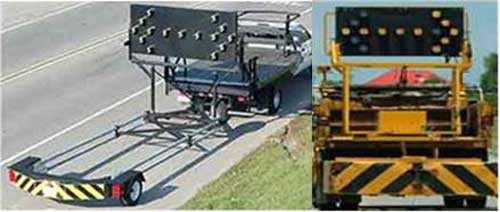
Photos 4(left) and 5(right) show examples of truck mounted attenuators.
Recently a fire department equipped a surplus municipal dump truck with lights, siren, reflective chevron strips on the back, a lighted road arrow sign, and a crash attenuator (see Photo 6 and Photo 7.) The truck was designed for use at roadway emergency incident scenes to protect the parked apparatus from moving traffic by placing it upstream directly to the back of the blocking apparatus. 15
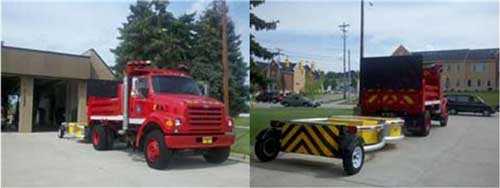
Photos 6(left) and 7(right) show a surplus municipal dump truck that was converted into a truck mounted attenuator.
(Photos courtesy of Grand Rapids, MI, Fire Department).
NFPA1500 Standard on Fire Department Occupational Safety and Health Program provides guidance on the use of warning and transitional devices that are used for traffic control at roadway emergency incidents. When the use of signs and transitional devices are required, NFPA 1500 requires that fluorescent and retro-reflective warning devices such as traffic cones and signs, as well as illuminated warning devices, such as highway flares, be used to warn oncoming traffic of an emergency work zone.3 The MUTCD designates fluorescent pink with black text as the best color for warning signs to identify active emergency work zones. Warning signs, flares and cones can improve the identification of fire apparatus, personnel and the emergency work zone. Flares used in conjunction with traffic cones with reflective collars can be very effective at channeling traffic around an incident scene.10 A model SOP for establishing advance warning and transition areas at highway-related incidents can be found at http://www.respondersafety.com/default.aspx.16 (Link updated 10/28/2013)
When traffic control calls for a traffic control assistant at limited-access highway operations, fire departments should consider assigning a member to monitor approaching traffic and activate an emergency signal if the actions of a motorist do not conform to established traffic control measures that are in place at the incident scene. Traffic control assistants should be identified by the department in advance and training that is specific to the functions of the position should be provided. A traffic control assistant training program can be found by accessing the Responder Safety Institute website, http://www.respondersafety.com/DownloadCategories/Training.aspx.17 (Link updated 10/28/2013) Additionally, NFPA 1091, Standard for Traffic Control Incident Management Professional Qualifications (currently under development and is in draft status), will identify the minimum job performance requirements necessary to perform temporary traffic control duties at emergency incidents on, or near an active roadway.18
In this incident, it is possible that a traffic control assistant who was monitoring on-coming traffic from a safe vantage point, could have alerted all persons at the scene in time for them to move safely out of the path of the out-of-control truck.
In this incident, there was not an advance warning or traffic transition area established due to the numerous unique factors such as the rare occurrence of a hail storm in the area, the large number of traffic crashes because of the slippery road surface occurring during the same time period, and the resulting limited availability of emergency responders. The fact that the MVARS in the parked highway patrol car captured images of 78 vehicles passing through the incident area safely during the same time frame provides evidence that the roadway could be navigated safely. This incident serves as a reminder that regardless of the circumstances, when responding to roadway incidents, multiple prevention strategies are always the optimum practice.
Recommendation #7: Fire departments should ensure that fire fighters wear suitable high-visibility retro-reflective apparel while working non-fire emergency scenes near moving traffic.
Discussion: The Victim in this incident was wearing an ANSI-compliant retro-reflective vest. The following information is being provided to assist fire departments when selecting safety apparel for responding to roadway incidents.
To meet minimum requirements for high visibility apparel, responders should only use vests that meet a Class II requirement of ANSI/ISEA 107-2004 (or subsequent revisions) or the requirements of ANSI/ISEA 207-2006 for Public Safety Vests. These minimum requirements include 1) use of fluorescent background material, 2) the fluorescent material may be yellow-green, orange-red, or red, 3) retro-reflective material arranged for 360 degree visibility and, 4) the garments should be labeled as compliant with ANSI/ISEA 107-2010 or ANSI/ISEA 207-2006.19 NFPA 1500 8.7.10 states, "when members are operating at a traffic incident and their assignment places them in potential conflict with motor vehicle traffic, they shall wear a garment with fluorescent and retro-reflective material visible from all directions.3 All responders who are not involved in fire suppression activities should be wearing ANSI compliant high visibility garments when working near moving traffic and don the retro-reflective vests during scene clean-up following extinguishment.
Recommendation #8: Fire departments should ensure that high visibility chevrons and reflective markings are applied to all apparatus to enhance conspicuity while parked at emergency scenes and during emergency response.
Discussion: Highway incident scene safety has been at the forefront of efforts to reduce fire fighter death and injury. Several initiatives to increase conspicuity of emergency apparatus have been finalized and guidance has been provided to assist fire departments in implementing these procedures.20 NFPA 1901, Standard for Automotive Fire Apparatus, was revised and became effective in January 2009. Its purpose is to enhance visibility of emergency vehicles that are parked along roadways during emergency incidents. Chapter 1.3.1 states that " This standard shall apply to new fire apparatus that meet the following criteria: (1) That have 10,000 pounds (4500 kg) or greater gross vehicle weight rating (GVWR) or are trailers intended to be towed by fire apparatus under emergency response conditions. (2) That are designed for use under emergency conditions to transport personnel and equipment and to support the suppression of fires and mitigation of other hazardous situations, or (3) That are contracted for on or after January 1, 2009." The specific marking requirements are outlined in NFPA 1901 Chapter 15.9.3.1 and 15.9.3.2 which state that "A retro-reflective stripe(s) shall be affixed to at least 50 percent of the cab and body length on each side, excluding the pump panel areas, and at least 25 percent of the width of the front of the apparatus. The stripe or combination of stripes shall be a minimum of 4 inches (100 mm) in total width. At least 50 percent of the rear-facing vertical surfaces, visible from the rear of the apparatus, excluding any pump panel areas not covered by a door, shall be equipped with retro-reflective striping in a chevron pattern sloping downward and away from the centerline of the apparatus at an angle of 45 degrees."21 NFPA 1901 applies to newly manufactured apparatus and is not retroactive. However, in many cases it can be cost effective and easy to retrofit existing apparatus to improve fire fighter emergency work zone safety. Fire departments should consider putting reflective tape on apparatus to mark doors, fixed sections that are not blocked by doors or ladder racks, and also down low around the bottom of the apparatus. A video detailing guidance for retrofitting apparatus with the newly recommended safety lighting and markings can be found by accessing the Emergency Responder Safety Institute website, http://www.respondersafety.com/MarkedAndSeen.aspx.21
Roadway incident response safety procedures call for fire apparatus to park on an angle at roadway incident scenes to create a work area that is protected from passing traffic. Often apparatus emergency lighting is not as effective when parked at an angle. A more effective design calls for emergency lights to be mounted up high on the back of the apparatus to provide 360º visibility. There is evidence that amber lighting on the rear of apparatus can be very effective at warning motorists of an active emergency work zone. Amber lights convey a message of caution and motorists are accustomed to slowing down for amber warning lights in highway construction work zones.22
The photos below (see Photo 8 and Photo 9) show an example of reflective directional arrow markings that have been applied to the sides of a rescue unit. These side markings are arrow shaped to present a visual message that will direct motorists around and away from the emergency work zone. Amber directional lighting has also been installed on the upper rear sides to improve visibility when the truck is parked at an angle.
At the time the pickup truck was approaching the emergency scene, the highway patrol car and the fire department patrol vehicle had their emergency lights activated. The patrol car also had an operating amber directional arrow to direct traffic to the left.

Photos 8(left) and 9(right) show reflective directional arrow markings in daylight and darkness.
(Photo courtesy of North Washington
Fire Protection District, Denver, CO).
Recommendation #9: Fire departments should ensure that all persons involved in training and operations of emergency response meet all applicable requisite knowledge and skills.
Discussion: NFPA 1500, Standard On Fire Department Occupational Safety and Health Program states that , "the fire department shall provide training, education and professional development for all department members commensurate with the duties and functions that they are expected to perform." 3 NFPA 1001, Standard For Fire Fighter Professional Qualifications states that in order for fire fighters to operate safely in work areas at emergences they need to be trained to recognize the potential hazards involved including vehicle traffic, utilities, and environmental conditions; proper procedures for dismounting apparatus in traffic; procedures for safe operation at emergency scenes; and the protective equipment available for members' safety on emergency scenes. They must have the ability to use personal protective clothing, deploy traffic and scene control devices, dismount apparatus, and operate in the protected work areas as directed.23 NFPA 1021, Standard for Fire Officer Professional Qualifications, states that one of the fire officer's duties is to implement and/or recommend changes to existing departmental policies and communicate to all members ensuring all policies and/or changes are understood. Officers must have written and oral communications skills and the ability to relate interpersonally and to communicate change in a positive manner.24
References
- Weather underground [2012]. History Saturday, February 29, 2012: http://www.wunderground.com/history/airport/KRDD/2012/2/29/DailyHistory.html?req_city=NA&req_state=NA&req_statename=NA. Date accessed: March 2013.
- A SOP Word template "SOP/SOG For Your Fire Department Safe Positioning While Operating or Near Moving Traffic" http://www.respondersafety.com/Download.aspx?downloadID=2c3b900d-bf89-4142-acee-063397f372aa Date accessed: March 2013.
- NFPA [2013]. NFPA 1500, Standard on fire department occupational safety and health program. 2013 ed. Quincy, MA: National Fire Protection Association.
- NFPA [2013]. NFPA 1451, Standard for a fire and emergency services vehicle operations training program. 2013 ed. Quincy, MA: National Fire Protection Association.
- Protecting Emergency Responders on the Highways. Responder Safety Institute website: http://www.respondersafety.com/DownloadCategories/White_Papers.aspx. Date accessed: March 2013.
- US Fire Administration [2008]. Traffic Incident Management Systems. Emmitsburg, MD: Federal Emergency Management Agency, US Fire Administration. www.usfa.fema.gov/downloads/pdf/publications/tims_0408.pdf Date accessed: March 2013. (Link updated 10/28/2013)
- NFPA [2010]. NFPA 1620. Standard for pre-incident planning. 2010 ed. Quincy, MA: National Fire Protection Association.
- International Association of Fire Fighters [2010]. IAFF Emergency Vehicle Safety Program. http://www.iaff.org/hs/EVSP/home.html Date accessed: August 2013.
- NIOSH [2001]. NIOSH Hazard ID: Traffic Hazards to Fire Fighters While Working Along Roadways. Cincinnati, OH: U.S. Department of Health and Human Services, Public Health Service, Center for Disease Control and Prevention, National Institute for Occupational Safety and Health, DHHS (NIOSH) Publication No. 2001-143. http://www.cdc.gov/niosh/docs/2001-143/. Date accessed: June 2013.
- FHWA [2009]. Manual on Uniform Traffic Control Devices. Washington, DC: U.S. Department of Transportation, Federal Highway Administration (FHWA). http://mutcd.fhwa.dot.gov/htm/2009/html_index.htm. Date accessed: March 2013.
- NFPA [2008]. NFPA 1561: Standard on emergency services incident management system. 2008 ed. Quincy, MA: National Fire Protection Association.
- NIOSH [2009]. NIOSH Report: Volunteer fire fighter sitting in his parked vehicle warning oncoming traffic of a motor vehicle incident was struck and killed by a tractor-trailer - Montana. U.S. Department of Health and Human Services, Public Health Service, Centers for Disease Control and Prevention, National Institute for Occupational Safety and Health, DHHS (NIOSH) Publication No. F2009-03. http://www.cdc.gov/niosh/fire/reports/face200903.html. Date accessed: March 2013.
- Simplified Guide to the Incident Command System for Transportation Professionals. http://ops.fhwa.dot.gov/publications/ics_guide/. Date accessed: March 2013.
- National Capital Regional Transportation Planning Board [2010]. Long Range Transportation Plan/ State Strategic Highway Safety Plans. http://www.mwcog.org/clrp/elements/safety/shsps.asp. Date accessed: March 2013.
- GRFD Unveils Its Traffic Safety Unit [2011]. http://www.youtube.com/watch?v=1JAqE99iAaA. Date accessed: March 2013.
- Model Standard Operating Guideline (SOG) for Cone, Flare, or Sign Deployment at Traffic-related Incidents. Responder Safety website: http://www.respondersafety.com/Articles/Model_SOG_Available_for_Download_on_Deploying_Cones_and_Flares_at_Roadway_Incidents.aspx. Date accessed: March 2013.
- Developing Traffic Assistant Control Programs. Emergency Responder Safety Institute website: http://www.respondersafety.com/DownloadCategories/Training.aspx. Date accessed: March 2013. (Link updated 10/28/2013)
- NFPA 1091[2015 draft]. NFPA 1091, Standard for traffic control incident management professional qualifications. 2015 ed. (draft). Quincy, MA: national Fire Protection Association.
- FHWA [2009]. Manual on Uniform Traffic Control Devices. Washington, DC: U.S. Department of Transportation, Federal Highway Administration (FHWA). http://mutcd.fhwa.dot.gov/htm/2009/part6/part6d.htm . Date accessed: June 2013.
- Sullivan J [2009]. Innovations In Apparatus Conspicuity http://www.firerescue1.com/print.asp?act=print&vid=508854. Date accessed: March 2013.
- NFPA [2009]. NFPA 1901, Standard for automotive fire apparatus. 2009 ed. Quincy, MA: National Fire Protection Association.
- Marked and Seen, Emergency Responder Safety Institute website, http://www.respondersafety.com/MarkedAndSeen.aspx. Date accessed: March 2013.
- NFPA 1001 [2013]. NFPA 1001, Standard for fire fighter professional qualifications. 2013 ed. Quincy, MA: National Fire Protection Association.
- NFPA 1021 [2009]. NFPA 1021, Standard for fire officer professional qualifications. 2009 ed. Quincy, MA: National Fire Protection Association.
Additional Information
- USFA Emergency Vehicle Safety - http://www.usfa.fema.gov/fireservice/research/safety/vehicle.shtm
- USFA Roadway Operations Safety - http://www.usfa.fema.gov/fireservice/research/safety/roadway.shtm
- Situational Awareness: Think past, present and future.
http://www.samatters.com/situational-awareness-think-past-present-future/ (Link updated 10/28/2013)
Investigator Information
This incident was investigated by Virginia Lutz, Safety and Occupational Health Specialist, Fire Fighter Fatality Investigation and Prevention Team, Surveillance and Field Investigations Branch, Division of Safety Research, NIOSH located in Morgantown, WV. This report was authored by Virginia Lutz. An expert technical review was conducted by Chief Richard Gasaway, Ph.D., EFO, CFO, and the National Fire Protection Association, Public Fire Protection Division.
Disclaimer
Mention of any company or product does not constitute endorsement by the National Institute for Occupational Safety and Health (NIOSH). In addition, citations to Web sites external to NIOSH do not constitute NIOSH endorsement of the sponsoring organizations or their programs or products. Furthermore, NIOSH is not responsible for the content of these Web sites.
Acknowledgement
The NIOSH Fire Fighter Fatality Investigation and Prevention Program would like to acknowledge the California Highway Patrol for their assistance with this investigation.
The National Institute for Occupational Safety and Health (NIOSH), an institute within the Centers for Disease Control and Prevention (CDC), is the federal agency responsible for conducting research and making recommendations for the prevention of work-related injury and illness. In 1998, Congress appropriated funds to NIOSH to conduct a fire fighter initiative that resulted in the NIOSH “Fire Fighter Fatality Investigation and Prevention Program” which examines line-of-duty-deaths or on duty deaths of fire fighters to assist fire departments, fire fighters, the fire service and others to prevent similar fire fighter deaths in the future. The agency does not enforce compliance with State or Federal occupational safety and health standards and does not determine fault or assign blame. Participation of fire departments and individuals in NIOSH investigations is voluntary. Under its program, NIOSH investigators interview persons with knowledge of the incident who agree to be interviewed and review available records to develop a description of the conditions and circumstances leading to the death(s). Interviewees are not asked to sign sworn statements and interviews are not recorded. The agency's reports do not name the victim, the fire department or those interviewed. The NIOSH report's summary of the conditions and circumstances surrounding the fatality is intended to provide context to the agency's recommendations and is not intended to be definitive for purposes of determining any claim or benefit.
For further information, visit the program Web site at www.cdc.gov/niosh/fire or
call toll free 1-800-CDC-INFO (1-800-232-4636).
- Page last reviewed: November 18, 2015
- Page last updated: October 15, 2014
- Content source:
- National Institute for Occupational Safety and Health Division of Safety Research


 ShareCompartir
ShareCompartir